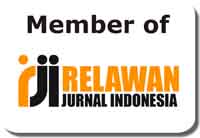Interaction Between Self-Efficacy and Instrumental Motivation among Indonesian L2 Learners of English
Abstract
Keywords
Full Text:
PDFReferences
Al-Munawwarah, S. F. (2018). Students’ motivation in EFL learning. TELL-US Journal, 4(2), 107–119. https://doi.org/10.22202/tus.2018.v4i2.2779
Al-Oliemat, D. A. (2019). Motivation and attitudes towards learning English among Saudi female English majors at Dammam University. International Journal of Language & Literature, 7(1), 121–137. https://doi.org/10.15640/ijll.v7n1a15
Al-Ta’ani, M. H. (2018). Integrative and instrumental motivations for learning English as a university requirement among undergraduate students at Al-Jazeera University/Dubai. International Journal of Learning and Development, 8(4), 89–105. https://doi.org/10.5296/ijld.v8i4.13940
Ametova, O. R. (2020). The influence of integrative motivation and instrumental motivation on learning English as a foreign language. Journal of Critical Reviews, 7(12), 942–945. https://doi.org/10.31838/jcr.07.12.164
Asakereh, A., & Dehghannezhad, M. (2015). Student satisfaction with EFL speaking classes: Relating speaking self-efficacy and skills achievement. Issues in Educational Research, 25(4), 345–363. http://www.iier.org.au/iier25/asakereh.pdf
Aspuri, N., Samad, I. A., Fitriani, S. S., & Abdul Samad, N. M. (2019). The role of instrumental motivation among EFL students in language learning process. Journal of English Education, 4(1), 48–53. https://doi.org/10.31327/jee.v4i1.892
Bandura, A. (1997). Self-efficacy: The exercise of control. W. H. Freeman and Company.
Carrió-Pastor, M. L., & Mestre, E. M. M. (2014). Motivation in second language acquisition. Procedia - Social and Behavioral Sciences, 116(2002), 240–244. https://doi.org/10.1016/j.sbspro.2014.01.201
Coskun, L. (2014). Investigating the essential factors on students motivation through comparing boys and girls in terms of instrumental & integrative motivation in EFL classrooms. Journal of Educational and Social Research, 4(2), 150–156. https://doi.org/10.5901/jesr.2014.v4n2p150
Davis, C. S., & Lachlan, K. A. (2017). Straight talk about communication research methods (3rd ed.). Kendall Hunt Publishing.
Dewaele, J., & Dewaele, L. (2018). Learner-internal and learner-external predictors of willingness to communicate in the FL classroom. Journal of European Second Language Association, 2(1), 1–14. https://doi.org/https://doi.org/10.22599/jesla.37
Doğan, C. (2016). Self-efficacy and anxiety within an EFL context. Journal of Language and Linguistic Studies, 12(2), 54–65. https://files.eric.ed.gov/fulltext/EJ1117949.pdf
Dörnyei, Z. (1998). Motivation in second and foreign language learning. Language Teaching, 31(3), 117–135. https://doi.org/10.1017/S026144480001315X
Ersanlı, C. Y. (2015). The relationship between students’ academic self-efficacy and language learning motivation: A study of 8th graders. Procedia - Social and Behavioral Sciences, 199, 472–478. https://doi.org/10.1016/j.sbspro.2015.07.534
Fatemi, A. H., & Vahidnia, F. (2013). Self-efficacy and motivation among Iranian EFL learners: An investigation into their relationships. International Journal of English Language Education, 1(3), 79–89. https://doi.org/10.5296/ijele.v1i3.3771
Gardner, R. C. (1985). Social psychology and second language learning: The role of attitudes and motivations. Edward Arnold.
Gardner, R. C., & Lambert, W. (1959). Motivational variables in second language acquisition. Canadian Journal of Psychology, 13, 266–272.
Gardner, R. C., & Lambert, W. E. (1972). Attitudes and motivation in second language learning. Newbury House Publishers Inc.
Genc, Z. S., & Aydin, F. (2017). An analysis of learners’ motivation and attitudes toward learning English language at tertiary level in Turkish EFL context. English Language Teaching, 10(4), 35. https://doi.org/10.5539/elt.v10n4p35
Gilakjani, A. P., Leong, L.-M., & Sabouri, N. B. (2012). A Study on the role of motivation in foreign language learning and teaching. International Journal of Modern Education and Computer Science, 4(7), 9–16. https://doi.org/10.5815/ijmecs.2012.07.02
Gray, D. E. (2022). Doing research in the real world (5th ed.). Sage Publications, Ltd.
Hong, Y. C., & Ganapathy, M. (2017). To investigate ESL students’ instrumental and integrative motivation towards English language learning in a Chinese school in Penang: cases study. English Language Teaching, 10(9), 17–35. https://doi.org/10.5539/elt.v10n9p17
Husain, U. K. (2014). Relationship between self-efficacy and academic motivation. International Conference on Economics, Education and Humanities, 14, 18–22. https://doi.org/10.15242/icehm.ed1214132
Israel, M., & Hay, I. (2006). Research ethics for social scientists. SAGE Publications Ltd.
Kashefian-Naeeini, S., Aminlari, F., & Mousavi, H. (2018). An investigation into attitudes towards learning English and the motivation type (integrative vs. instrumental) in Iranian students at University Kebangsaan Malaysia. International Journal of English Language & Translation Studies, 6(3), 204–213. http://www.eltsjournal.org/archive/value6 issue3/23-6-3-18.pdf#
Mantasiah, R., & Yusri, Y. (2018). Pay it forward model in foreign language learning to increase student’s self efficacy and academic motivation. Journal of Physics: Conference Series, 1028(1). https://doi.org/10.1088/1742-6596/1028/1/012178
Matsuda, A., & Friedrich, P. (2011). English as an international language. World Englishes, 30(3), 332–344. https://doi.org/10.1515/9783110243345.172
Matsuzaki-Carreira, J. (2005). New framework of intrinsic/extrinsic and integrative/instrumental motivation in second language acquisition. The Keiai Journal of International Studies, 16(16), 39–64. https://www.u-keiai.ac.jp/issn/menu/ronbun/no16/039.pdf
Mills, N., Pajares, F., & Herron, C. (2006). A reevaluation of the role of anxiety: Self-efficacy, anxiety, and their relation to reading and listening proficiency. Foreign Language Annals, 39(2), 276–295. https://doi.org/10.1111/j.1944-9720.2006.tb02266.x
Mills, N., Pajares, F., & Herron, C. (2007). Self-efficacy of college intermediate French students: Relation to achievement and motivation. Language Learning, 57(3), 417–442. https://doi.org/10.1111/j.1467-9922.2007.00421.x
Muslim, A. B., Hamied, F. A., & Sukyadi, D. (2020). Integrative and instrumental but low investment: The English learning motivation of Indonesian senior high school students. Indonesian Journal of Applied Linguistics, 9(3), 493–507. https://doi.org/10.17509/ijal.v9i3.23199
Ng, C. F., & Ng, P. K. (2015). A Review of intrinsic and extrinsic motivations of ESL learners. International Journal of Languages, Literature and Linguistics, 1(2), 98–105. https://doi.org/10.7763/ijlll.2015.v1.20
Noviana, N., & Ayu, M. (2022). An investigating EFL learners’ instrumental motivation in learning English. Journal of Research on Language Education, 3(2), 49. https://doi.org/10.33365/jorle.v3i2.2149
Öztürk, G., & Güzbür, N. (2015). Motivational orientations of Turkish EFL students: The case at a state university. Journal of Language and Literature Education, 2(8), 17. https://doi.org/10.12973/jlle.11.215
Roshandel, J., Ghonsooly, B., & Ghanizadeh, A. (2018). L2 motivational self-system and self-efficacy: A quantitative survey-based study. International Journal of Instruction, 11(1), 329–344. https://doi.org/10.12973/iji.2018.11123a
Saragih, T. Y., & Subekti, A. S. (2024). Instrumental motivation and L2 speaking achievement of Indonesian L2 learners of English: A survey study. Folios, 60.
Şener, S., & Erol, İ. K. (2017). Motivational orientations and self-efficacy beliefs of Turkish students towards EFL learning. Egitim Arastirmalari - Eurasian Journal of Educational Research, 2017(67), 251–267. https://doi.org/10.14689/ejer.2017.67.15
Siahaan, A., Ardayati, A., & Ramasari, M. (2022). The importance of instrumental motivation among students in teaching English as foreign language (TEFL) process. Education of English as a Foreign Language Journal, 5(1), 1–12. https://doi.org/10.21776/ub.educafl.2022.005.01.01
Smith, S. L., Kathleen Pichora-Fuller, M., Watts, K. L., & La More, C. (2011). Development of the listening self-efficacy questionnaire (LSEQ). International Journal of Audiology, 50(6), 417–425. https://doi.org/10.3109/14992027.2011.553205
Subekti, A. S. (2020). Self-perceived communication competence and communication apprehension: A study of Indonesian college students. EduLite: Journal of English Education, Literature, and Culture, 5(1), 14–31. https://doi.org/http://dx.doi.org/10.30659/e.5.1
Sukri, N. A. P. S., Nasmilah, N., & Jubhari, R. R. (2021). The orientation in learning English (a study of the causal factors of students’ integrative and instrumental motivation). ELS Journal on Interdisciplinary Studies in Humanities, 4(4), 494–500. https://doi.org/10.34050/elsjish.v4i4.19115
Tahaineh, Y., & Daana, H. (2013). Jordanian undergraduates ’ motivations and attitudes towards learning English in EFL context. International Review of Social Sciences and Humanities, 4(2), 159–180.
Teng, L. S., Sun, P. P., & Xu, L. (2017). Conceptualizing writing self-efficacy in English as a foreign language contexts: Scale validation through structural equation modeling. TESOL Quarterly, 52(4), 911–942. https://doi.org/10.1002/tesq.432
Torres, J. M., & Alieto, E. O. (2019). English learning motivation and self-efficacy of Filipino senior high school students. Asian EFL Journal, 22(1), 51–72.
Wimolmas, R. (2012). A survey study of motivation in English language learning of first year undergraduate students at Sirindhorn International Institute of Technology (SIIT), Thammasat University. FLLT Conference Proceedings by LITU, 2(1), 904–915.
Zanghar, A. (2012). Instrumental and integrative motivation among undergraduate Libyan students of English as a foreign language. In ProQuest Dissertations and Theses (Issue 2010). Colorado State University.
DOI: http://dx.doi.org/10.31332/lkw.v0i0.7828
Copyright (c) 2024 Yohanes Septian Sinaga, Adaninggar Septi Subekti

This work is licensed under a Creative Commons Attribution-ShareAlike 4.0 International License.
Langkawi: Journal of The Association for Arabic and English indexed by:


















.png)
.png)

.png)
2.png)








